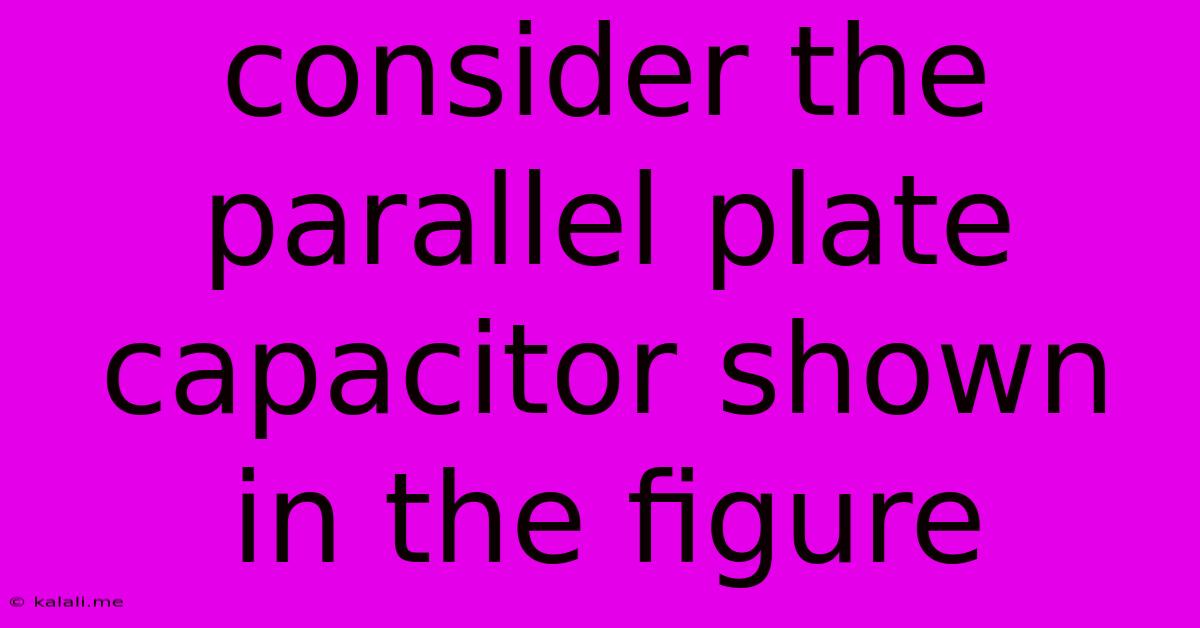Consider The Parallel Plate Capacitor Shown In The Figure
Kalali
Jun 15, 2025 · 3 min read

Table of Contents
Understanding the Parallel Plate Capacitor: A Comprehensive Guide
Meta Description: This article provides a comprehensive explanation of parallel plate capacitors, covering their structure, capacitance calculation, applications, and limitations. Learn about factors affecting capacitance and explore real-world uses.
The parallel plate capacitor is a fundamental component in electronics, forming the basis for understanding more complex capacitor designs. This article delves into the physics and applications of this essential device. We'll explore its construction, capacitance calculation, factors influencing its performance, and typical real-world applications.
What is a Parallel Plate Capacitor?
A parallel plate capacitor, at its simplest, consists of two conducting plates of equal area placed parallel to each other, separated by a dielectric material. This dielectric acts as an insulator, preventing direct current flow between the plates but allowing for the storage of electrical energy in the form of an electric field. The plates themselves are typically made from conductive materials like metal foil or plates. The dielectric could be air, vacuum, ceramic, plastic, or other insulating materials. The choice of dielectric significantly affects the capacitor's properties.
Calculating Capacitance
The capacitance (C) of a parallel plate capacitor is directly proportional to the area (A) of the plates and the permittivity (ε) of the dielectric material, and inversely proportional to the distance (d) separating the plates. This relationship is expressed mathematically as:
C = εA/d
Where:
- C is the capacitance measured in Farads (F).
- ε is the permittivity of the dielectric material. This is often expressed as ε = ε₀εᵣ, where ε₀ is the permittivity of free space (approximately 8.854 x 10⁻¹² F/m) and εᵣ is the relative permittivity (dielectric constant) of the material.
- A is the area of each plate in square meters (m²).
- d is the distance between the plates in meters (m).
This formula highlights the key factors that determine a capacitor's ability to store charge. Increasing the plate area or using a dielectric with a higher permittivity increases capacitance. Conversely, increasing the distance between the plates decreases capacitance.
Factors Affecting Capacitance
Beyond the basic formula, several other factors can subtly influence the capacitance of a parallel plate capacitor:
- Dielectric Strength: The dielectric material must withstand the applied voltage without breaking down. Exceeding the dielectric strength can lead to dielectric failure and capacitor damage.
- Edge Effects: The idealized formula assumes perfectly uniform electric fields between the plates. In reality, fringe fields exist at the edges of the plates, slightly altering the capacitance. This effect becomes more significant as the plate separation increases relative to the plate dimensions.
- Temperature: The permittivity of the dielectric material can vary with temperature, leading to changes in capacitance.
- Frequency: At high frequencies, the dielectric's response to the changing electric field might become frequency dependent leading to a decrease in capacitance.
Applications of Parallel Plate Capacitors
Parallel plate capacitors, while simple in design, find widespread use in various electronic applications:
- Energy Storage: In power supplies and energy storage systems, they store and release electrical energy quickly.
- Filtering: They are crucial components in filters, blocking direct current while allowing alternating current to pass.
- Tuning Circuits: Variable parallel plate capacitors are used in radio tuners to adjust the resonant frequency of a circuit.
- Coupling and Decoupling: They can couple or decouple signals in circuits, preventing unwanted interference.
- Sensors: Changes in capacitance can be used to measure physical quantities such as displacement, pressure, or humidity.
Limitations of Parallel Plate Capacitors
Despite their versatility, parallel plate capacitors have some limitations:
- Limited Capacitance: Achieving high capacitance often requires large plate areas or very small plate separations, making them physically bulky or prone to breakdown.
- Voltage Limitations: The dielectric's strength limits the maximum voltage that can be applied.
- Susceptibility to Environmental Factors: Changes in temperature, humidity, or pressure can affect capacitance.
Understanding the parallel plate capacitor is fundamental to grasping the principles of capacitance and its applications in electronics. By considering the factors influencing capacitance and its limitations, designers can effectively utilize these essential components in various applications.
Latest Posts
Latest Posts
-
The Outermost Layer Of The Sun Is Called
Jun 16, 2025
-
Which Of The Following Is Not An Equation
Jun 16, 2025
-
The Opportunity Cost Of Holding Money
Jun 16, 2025
-
Which Of The Following Statements Is True Regarding A Vpn
Jun 16, 2025
-
The Rorschach Inkblot Test Is An Example Of
Jun 16, 2025
Related Post
Thank you for visiting our website which covers about Consider The Parallel Plate Capacitor Shown In The Figure . We hope the information provided has been useful to you. Feel free to contact us if you have any questions or need further assistance. See you next time and don't miss to bookmark.